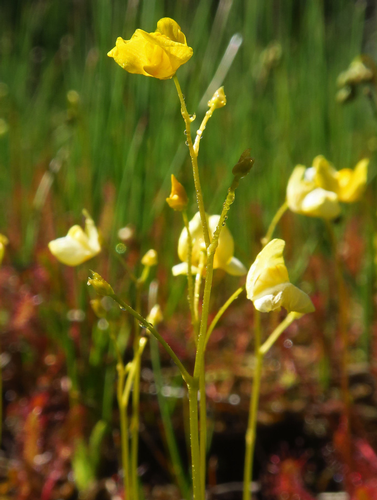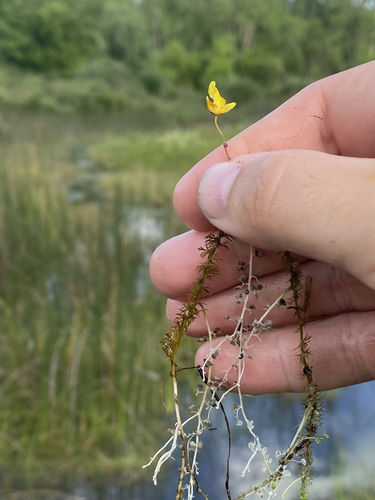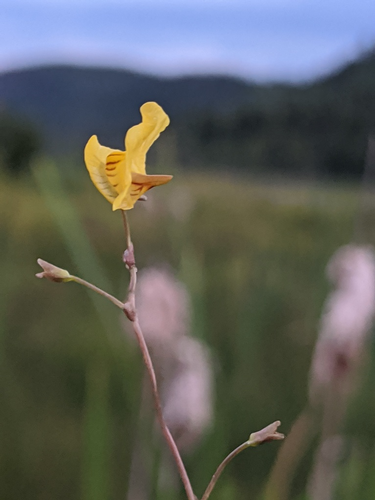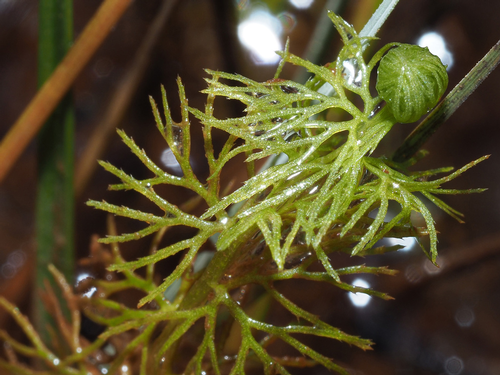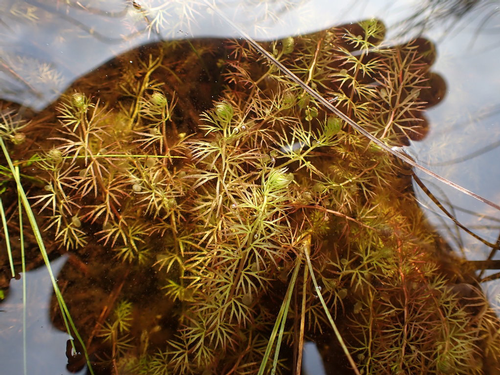Plants and Animals
Utricularia ochroleuca Northern bladderwort
Key Characteristics
A perennial, carnivorous, aquatic plant with stems reaching up to 30 cm and has bilaterally symmetrical, yellow flowers that are 10-15 mm long. They are distinct from the flat-leaved bladderwort flowers by their spur, which in northern bladderwort is about half as long as the lower lip. Leaves are alternate and many-forked. The bladders are on both the non-photosynthetic and photosynthetic shoots. With access to a microscope, another identifying feature is the obtuse angle between the short arms of the quadrifids.
Status and Rank
US Status: No Status/Not Listed
State Status: T - Threatened (legally protected)
Global Rank: G4G5 - Rank is uncertain, ranging from apparently secure to secure
State Rank: SNR - Not ranked
Occurrences
| County | Number of Occurrences | Year Last Observed |
|---|
Information is summarized from MNFI's database of rare species and community occurrences. Data may not reflect true distribution since much of the state has not been thoroughly surveyed.
Habitat
The known occurrences in Michigan are in Keweenaw County and were seen growing around the edge of an old beaver flooding. Observations in other states have been seen growing in acidic waters, around peaty lakes, and in bog and fen depressions.
Natural Community Types
For each species, lists of natural communities were derived from review of the nearly 6,500 element occurrences in the MNFI database, in addition to herbarium label data for some taxa. In most cases, at least one specimen record exists for each listed natural community. For certain taxa, especially poorly collected or extirpated species of prairie and savanna habitats, natural community lists were derived from inferences from collection sites and habitat preferences in immediately adjacent states (particularly Indiana and Illinois). Natural communities are not listed for those species documented only from altered or ruderal habitats in Michigan, especially for taxa that occur in a variety of habitats outside of the state.
Natural communities are not listed in order of frequency of occurrence, but are rather derived from the full set of natural communities, organized by Ecological Group. In many cases, the general habitat descriptions should provide greater clarity and direction to the surveyor. In future versions of the Rare Species Explorer, we hope to incorporate natural community fidelity ranks for each taxon.
Associated Plants
Ticklegrass (Agrostis spp.), nodding beggar-ticks (Bidens cernua), chickweed (Cerastium sp.), water hemlock (Cicuta bulbifera), spike-rush (Eleocharis acicularis), common horsetail (Equisetum arvense), water horsetail (E. fluviatile), spotted touch-me-not (Impatiens capensis), jointed rush (Juncus articulatis), cut grass (Leersia oryzoides), smartweed (Persicaria sp.), broad-leaved cat-tail (Typha latifolia), flat-leaved bladderwort (U. intermedia), and small bladderwort (U. minor).
Management Recommendations
A status survey for this species is warranted to better understand its extent and habitat requirements in Michigan. This species requires conservation of adjacent open, peaty wetlands, regulation of nutrient inputs and algae growth, and protection of hydrological regimes.
Survey Methods
Random meander search covers areas that appear likely to have rare taxa, based on habitat and the judgment of the investigator.
-
Meander search?
-
Survey Period: From first week of June to second week of September
-
References
Survey References
- Elzinga, C.L., D.W. Salzer, and J.W. Willoughby. 1998. Measuring and Monitoring Plant Populations. The Nature Conservancy and Bureau of Land Management, Denver. BLM Technical Reference 1730-1. 477pp.
- Goff, G.F., G.A. Dawson, and J.J. Rochow. 1982. Site examination for Threatened and Endangered plant species. Environmental Management 6(4): 307-316
- Nelson, J.R. 1984. Rare Plant Field Survey Guidelines. In: J.P. Smith and R. York. Inventory of rare and endangered vascular plants of California. 3rd Ed. California Native Plant Society, Berkeley. 174pp.
- Nelson, J.R. 1986. Rare Plant Surveys: Techniques For Impact Assessment. Natural Areas Journal 5(3):18-30.
- Nelson, J.R. 1987. Rare Plant Surveys: Techniques for Impact Assessment. In: Conservation and management of rare and endangered plants. Ed. T.S. Elias. California Native Plant Society, Sacramento. 8pp.
Technical References
- Adamec, L. 2020. Biological flora of Central Europe: Utricularia intermedia Heyne, U. ochroleuca R. W. Hartm., U. stygia Thor and U. bremii Heer ex Kölliker. Perspectives in Plant Ecology, Evolution, and Systematics 44: 1-20.
- Bobrov, A.A., P.A. Volkova, Y.O. Kopylov-Guskov, O.A. Mochalova, A.E. Kravchuk, and D.M. Nekrasova. 2022. Unknown Sides of Utricularia (Lentibulariaceae) Diversity in East Europe and North Asia or How Hybridization Explained Old Taxonomic Puzzles. Perspectives in Plant Ecology, Evolution, and Systematics 54: 1-19.
- NatureServe. 2023. NatureServe Network Biodiversity Location Data accessed through NatureServe Explorer Web. <https://explorer.natureserve.org/>. Accessed 3 March, 2025.
- Reznicek, A.A., E.G. Voss, and B.S. Walters. 2011. Michigan Flora Online. University of Michigan. Web. <https://michiganflora.net/>. Accessed 31 March 2025.
- Rice, B.A. 2024. Utricularia ochroleuca, in Jepson Flora Project (eds.) Jepson eFlora, Revision 13. <https://ucjeps.berkeley.edu/eflora/eflora_display.php?tid=47610>. Accessed on 9 September 2025.
- Routledge, R., A. Graeff, and G.E. Crow. 2020. The Discovery of Utricularia ochroleuca (Lentibulariaceae), Yellowish-white Bladderwort, in Michigan. The Great Lakes Botanist 59: 239-245.


